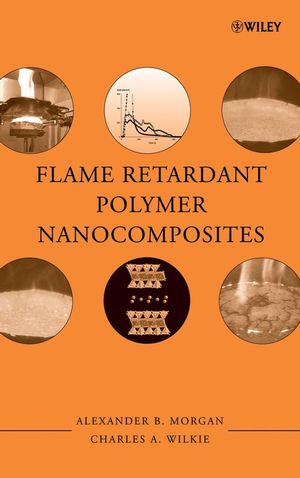Flame Retardant Polymer NanocompositesISBN: 978-0-471-73426-0
Hardcover
448 pages
April 2007
 This is a Print-on-Demand title. It will be printed specifically to fill your order. Please allow an additional 10-15 days delivery time. The book is not returnable.
|
||||||
Acronyms.
1 Introduction to Flame Retardancy and Polymer Flammability (Sergei V. Levchik).
1.1 Introduction.
1.2 Polymer Combustion and Testing.
1.3 Flame Retardancy.
1.4 Conclusions and Future Outlook.
References.
2 Fundamentals of Polymer Nanocomposite Technology (E. Manias, G. Polizos, H. Nakajima, and M. J. Heidecker).
2.1 Introduction.
2.2 Fundamentals of Polymer Nanocomposites.
2.3 Effects of Nanofillers on Material Properties.
2.4 Future Outlook.
References.
3 Flame Retardant Mechanism of Polymer–Clay Nanocomposites (Jeffrey W. Gilman).
3.1 Introduction.
3.2 Flame Retardant Mechanism.
3.3 Conclusions and Future Outlook.
References.
4 Molecular Mechanics Calculations of the Thermodynamic Stabilities of Polymer–Carbon Nanotube Composites (Stanislav I. Stoliarov and Marc R. Nyden).
4.1 Introduction.
4.2 Background and Context.
4.3 Description of the Method.
4.4 Application to PS–CNT Composites.
4.5 Uncertainties and Limitations.
4.6 Summary and Conclusions.
References.
5 Considerations Regarding Specific Impacts of the Principal Fire Retardancy Mechanisms in Nanocomposites (Bernhard Schartel).
5.1 Introduction.
5.2 Influence of Nanostructured Morphology.
5.3 Fire Retardancy Effects and Their Impact on the Fire Behavior of Nanocomposites.
5.4 Assessment of Fire Retardancy.
5.5 Summary and Conclusions.
References.
6 Intumescence and Nanocomposites: a Novel Route for Flame-Retarding Polymeric Materials (Serge Bourbigot and Sophie Duquesne).
6.1 Introduction.
6.2 Basics of Intumescence.
6.3 Zeolites as Synergistic Agents in Intumescent Systems.
6.4 Intumescents in Polymer Nanocomposites.
6.5 Nanofillers as Synergists in Intumescent Systems.
6.6 Critical Overview of Recent Advances.
6.7 Summary and Conclusion.
References.
7 Flame Retardant Properties of Organoclays and Carbon Nanotubes and Their Combinations with Alumina Trihydrate (Gunter Beyer).
7.1 Introduction.
7.2 Experimental Process.
7.3 Organoclay Nanocomposites.
7.4 Carbon Nanotube Nanocomposites.
7.5 Summary and Conclusions.
References.
8 Nanocomposites with Halogen and Nonintumescent Phosphorus Flame Retardant Additives (Yuan Hu and Lei Song).
8.1 Introduction.
8.2 Preparation Methods and Morphological Study.
8.3 Thermal Stability.
8.4 Mechanical Properties.
8.5 Flammability Properties.
8.6 Flame Retardant Mechanism.
8.7 Summary and Conclusions.
References.
9 Thermoset Fire Retardant Nanocomposites (Mauro Zammarano).
9.1 Introduction.
9.2 Clays.
9.3 Thermoset Nanocomposites.
9.4 Epoxy Nanocomposites Based on Cationic Clays.
9.5 Epoxy Nanocomposites Based on Anionic Clays.
9.6 Polyurethane Nanocomposites.
9.7 Vinyl Ester Nanocomposites.
9.8 Summary and Conclusions.
References.
10 Progress in Flammability Studies of Nanocomposites with New Types of Nanoparticles (Takashi Kashiwagi).
10.1 Introduction.
10.2 Nanoscale Oxide-Based Nanocomposites.
10.3 Carbon-Based Nanocomposites.
10.4 Discussion of Results.
10.5 Summary and Conclusions.
References.
11 Potential Applications of Nanocomposites for Flame Retardancy (A. Richard Horrocks and Baljinder K. Kandola).
11.1 Introduction.
11.2 Requirements for Nanocomposite System Applications.
11.3 Potential Application Areas.
11.4 Future Outlook.
References.
12 Practical Issues and Future Trends in Polymer Nanocomposite Flammability Research (Alexander B. Morgan and Charles A. Wilkie).
12.1 Introduction.
12.2 Polymer Nanocomposite Structure and Dispersion.
12.3 Polymer Nanocomposite Analysis.
12.4 Changing Fire and Environmental Regulations.
12.5 Current Environmental Health and Safety Status for Nanoparticles.
12.6 Commercialization Hurdles.
12.7 Fundamentals of Polymer Nanocomposite Flammability.
12.8 Future Outlook.
References.
Index.



